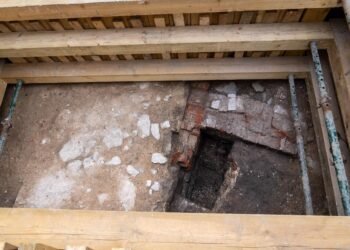Archaeologists have uncovered evidence of smallpox in the remains of two toddlers buried in a 16th-century cemetery in Huanchaco, a small fishing town on the northwest coast of Peru.
The cemetery, associated with one of the earliest colonial churches built by the Spanish between 1535 and 1540, revealed 120 burials representing the early-colonial population. Among these, a significant 75% were children, with 67% of them being 5 years old or younger. This high number of child burials is strongly suggestive of a novel disease affecting a particularly vulnerable segment of the population with developing immune systems, the researchers noted in their study.
The study, published in the June issue of the International Journal of Paleopathology, highlights the remains of two children, approximately 18 months old at the time of their deaths. Their skeletons exhibited numerous destructive lesions in joints such as the shoulders, elbows, wrists, hips, knees, and ankles. These lesions, resembling moth-eaten holes, are consistent with osteomyelitis variolosa, a bone infection triggered by the smallpox virus.
These cases represent the earliest known instances of osteomyelitis variolosa in South America, a notable discovery given the numerous smallpox outbreaks that occurred after European contact. According to the study, the rate of skeletal changes in children younger than 5 who contract smallpox ranges from 5% to 20%. This suggests that many archaeological cases of smallpox remain unidentified.
Smallpox, caused by the variola virus, is a fast-acting infection that has existed for at least three millennia, with some of the earliest evidence found in the form of characteristic rashes on Egyptian mummies. The disease caused numerous epidemics over the centuries, resulting in millions of deaths until it was eradicated in 1980 through a global vaccination campaign. Despite this, there remains a lack of reliable data on small-scale epidemics and their impact on Indigenous populations.
The historical context suggests that smallpox likely arrived in northwest Peru with Francisco Pizarro and his soldiers in the late 1530s. The disease had devastating effects, with estimates indicating a loss of about 70% of the native Inca population by 1620. The introduction of smallpox and other infectious diseases dramatically altered the demographics and culture of the region.
The study also noted the presence of Christian reed crosses in the graves, indicating that the children were likely baptized and converted to Christianity, either voluntarily or forcefully. This reflects the significant cultural changes imposed by the Spanish colonizers.
The demographic data from the cemetery, showing a high prevalence of non-adult burials and a significant percentage of children under five, aligns with historical documentation of population declines and town abandonments along the coast between the Chicama and Moche valleys before 1580, including the Huanchaco area.
The researchers urge future archaeological studies to consider viral agents in differential diagnoses of skeletal lesions. By doing so, they hope to gain a fuller understanding of how viruses have impacted human evolution and cultural change.























